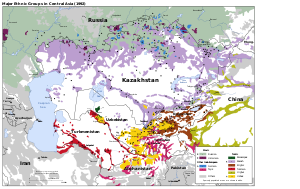
Back التركيبة السكانية لآسيا الوسطى Arabic Δημογραφία της Κεντρικής Ασίας Greek Demografía de Asia Central Spanish جمعیتشناسی آسیای میانه Persian Аҳолии Осиёи Марказӣ Tajik Orta Asya demografisi Turkish Markaziy Osiyo demografiyasi Uzbek



The nations which make up Central Asia are five of the former Soviet republics: Kazakhstan, Kyrgyzstan, Turkmenistan, Tajikistan and Uzbekistan, which have a total population of about 76 million.[1][2] Afghanistan is not always considered part of the region, but when it is, Central Asia has a total population of about 122 million (2016); Mongolia and Xinjiang (part of China) is also sometimes considered part of Central Asia due to its Central Asian cultural ties and traditions, although geographically it is East Asian.[1][2] Most central Asians belong to religions which were introduced to the area within the last 1,500 years, such as Sunni Islam, Shia Islam, Ismaili Islam, Tengriism and Syriac Christianity (mostly East Syriac).[3] Buddhism, however, was introduced to Central Asia over 2,200 years ago, and Zoroastrianism, over 2,500 years ago.[4]
- ^ a b "World Population Prospects 2022". United Nations Department of Economic and Social Affairs, Population Division. Retrieved July 17, 2022.
- ^ a b "World Population Prospects 2022: Demographic indicators by region, subregion and country, annually for 1950-2100" (XSLX) ("Total Population, as of 1 July (thousands)"). United Nations Department of Economic and Social Affairs, Population Division. Retrieved July 17, 2022.
- ^ "The World Factbook — Central Intelligence Agency". Cia.gov. Archived from the original on June 1, 2007. Retrieved 11 January 2018.
- ^ "The History of Zoroastrianism". Archived from the original on 2009-09-25. Retrieved 2010-02-18.